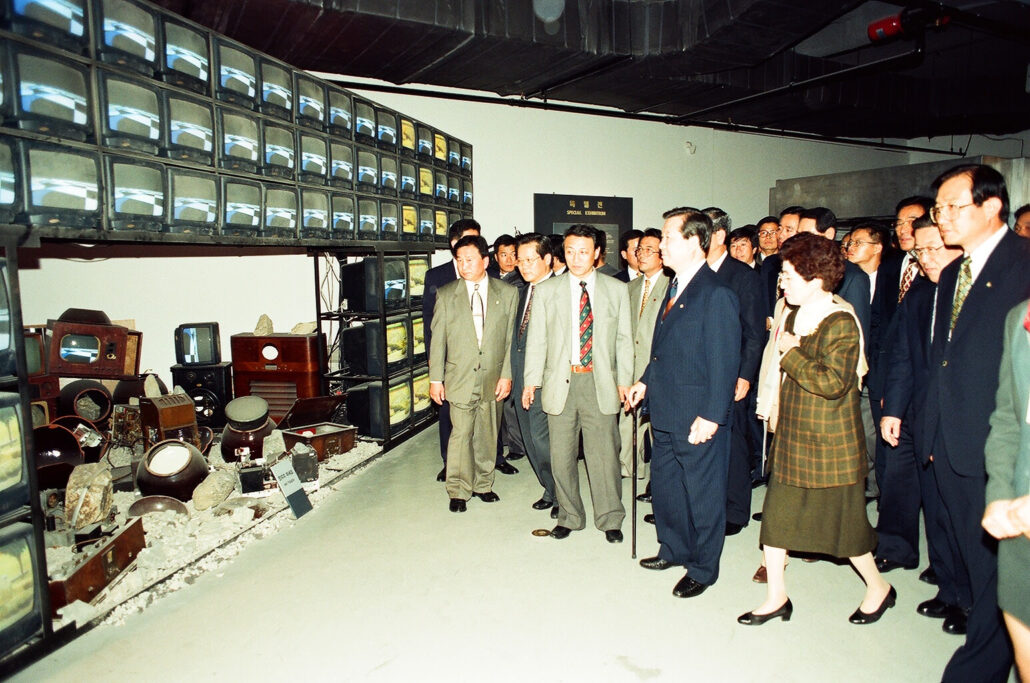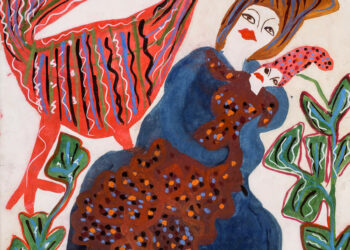‘Madang: Where We Become Us’, Gwangju Biennale Foundation’s 30th-anniversary special archive exhibition, highlights the Biennale’s role in the contemporary art scene as an open forum dedicated to the values of democracy, human rights, and community.

Nam June Paik, Dolmen, Installation View, 1995. Courtesy Gwangju Biennale Foundation.
Gwangju Biennale Foundation (President Yang-Woo Park) is pleased to announce the opening of ‘Madang: Where We Become Us’, a 221-day archival exhibition celebrating the Gwangju Biennale’s 30th anniversary from April 18 to November 24, 2024, at Il Giardino Bianco Art Space in Venice, Italy. Designated as one of the Venice Biennale’s 30 Collateral Events, this exhibition, presented in tandem with the Venice Biennale, is expected to share the foundation’s unique vision and the “Gwangju spirit” with viewers from across the globe.
The Gwangju Biennale Foundation was founded in 1994 at the intersection between art and the Gwangju spirit, which embodies the values of democracy, human rights, and community. Beginning with the inaugural edition in 1995, the Gwangju Biennale has grown into Asia’s representative contemporary art biennale. Organised by Gwangju Biennale Foundation in celebration of its 30th anniversary, the exhibition ‘Madang: Where We Become Us’ features the foundation’s collection of archival materials and artworks alongside other works that resonate with and expand on the meanings of the collected works. As an artistic madang (forum) for diversity and inclusivity – values the Biennale has pursued for the last 30 years – the exhibition proposes the potential of art as something worth sustaining. The exhibition also intends to shed light on the Gwangju spirit and redefine the Gwangju Biennale in light of contemporary times.
The word madang in the exhibition title means “yard,” “forum,” or “most important space” in Korean. Forming part of many traditional Korean residences, the madang has served as a place of meeting and communication, where feasts were held and big and small decisions concerning the village were made. Throughout its 30-year history, the Gwangju Biennale has also played the role of a madang, presenting visual artworks as a forum for discourse on human society and various other topics.
Just as neighbours have gathered in the open madang of traditional houses to share their stories and thoughts on communal issues, the Gwangju Biennale has embraced the different trends and cultures reflected in global art by positioning itself outside Western-centric art history to accommodate developing countries. The topics explored by the Gwangju Biennale over the years, including climate crisis, ethnicity, gender, and democracy, also testify to its attempt to transcend geographical boundaries and envision the future of the human community from a planetary perspective.
Park, president of Gwangju Biennale Foundation, notes, “The Gwangju Biennale, which began in the city of Gwangju, has pursued diversity for the past 30 years by embracing geographically and culturally diverse communities and initiating dialogues that could shape the history of human civilisation. Presented in Venice alongside the Venice Biennale, the special archival exhibition commemorating the Gwangju Biennale’s 30th anniversary will reflect on the Biennale’s initial purpose and hopefully serve as a madang where art breeds empathy, solidarity, and social practices on a global scale.”
The exhibition ‘Madang: Where We Become Us’ comprises three sections.
The first section offers a chronological overview of the Gwangju Biennale’s history and outlines significant events in its evolution. Posters, lists of participating art directors, curatorial members, and artists, exhibition themes, and maps of exhibition venues collectively introduce the last 14 iterations of the Gwangju Biennale, while a special documentary titled Gwangju Biennale, 30 Years of Perspective reflects on its footsteps, significance, and future objectives through interviews conducted with curators and artists who participated in the Biennale over the years.
The second section presents works from the Gwangju Biennale Foundation collection alongside works by three of Korea’s representative women artists that expand on the meanings of the collected works. Nam June Paik’s Dolmen (1995) and Kcho’s Para Olvidar: To Forget (1995), both owned by the foundation and featured in the inaugural edition of the Biennale, are presented next to works by the three contemporary artists to visualise the values the Biennale has pursued since its establishment. Dolmen, television monitors stacked in the shape of a megalith juxtaposed with Korean traditional objects such as crock pots, was produced in memory of the Gwangju community members sacrificed during the May 18 Democratisation Movement, while Kcho’s Para Olvidar: To Forget metaphors life as faced by the community of refugees who fled Cuba on a boat. Using the same commonplace objects – rafts, tyres, and battered boats – that Cuban refugees or “boat people” used to flee Cuba, Kcho visualised the urgency and danger of their escape as well as the precariousness of their lives. These two works summarise the history and orientation of the Gwangju Biennale while interacting with other works on display to highlight its pivotal concept of “community.” Meanwhile, the works by Kim Sylbee, Kim Ayoung, and Jun Sojung, three woman artists who have participated in previous iterations of the Gwangju Biennale, simultaneously inherit the spirit of and put a contemporary spin on Dolmen and Para Olvidar: To Forget.
This section also features a relic owned by the May 18 Democratic Uprising Archives: a tin bowl or hamjibak, which has come to symbolise the Gwangju spirit. This tin bowl was used by Gwangju mothers during the May 18 Democratisation Movement to hand out rice balls to the citizen militia and symbolise the communal bond among Gwangju citizens.
The third section comprises materials from the Gwangju Biennale Foundation’s archive that capture the Biennale’s progress. The historical materials featured here include exhibition posters, tickets, brochures, videotapes, CDs, exhibition blueprints, and digitised versions of materials in the archive.
For more information, please visit the Gwangju Biennale Foundation.



